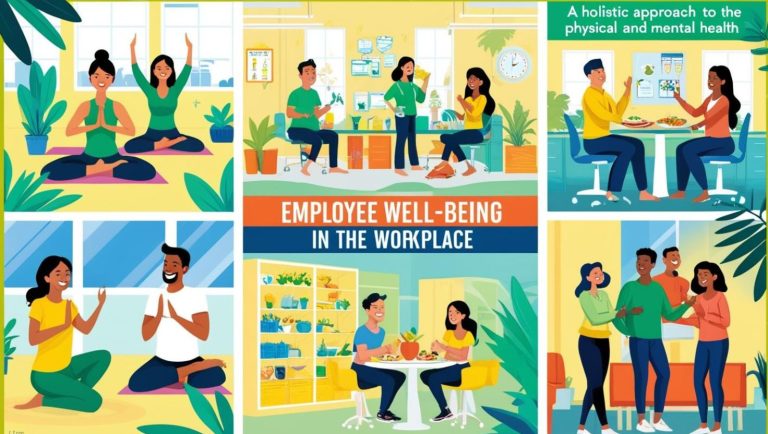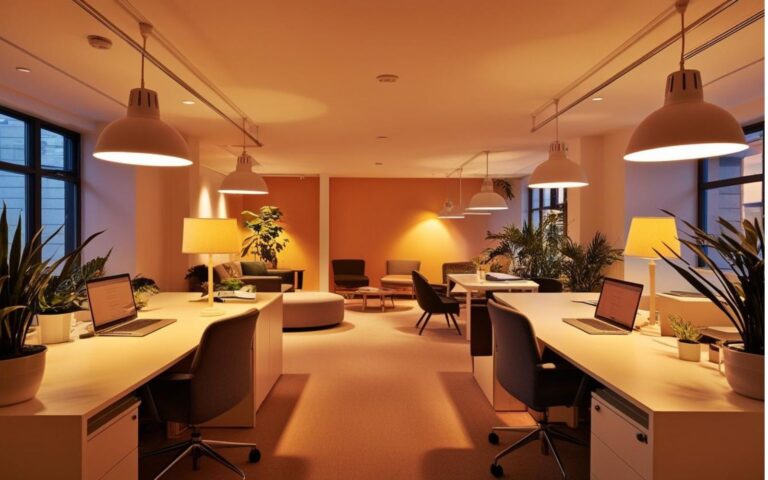Office Layouts That Promote Movement: More Productive Workspace By 8 Steps

Sitting for hours in one spot doesn’t just feel draining. Instead, it can also seriously affect your health and productivity. Thoughtfully designed office layouts that promote movement can completely transform your work environment and experience.
Whether designing a traditional office layout, a co-working office layout, or a home office layout, making movement-friendly changes can boost employee well-being, foster collaboration, and enhance productivity.
In this guide, we’ll walk you through innovative office layout ideas that support active collaboration, encourage movement, and create a more dynamic office environment.
Key Takeaways for Office Layouts That Promote Movement
- Promotes employee satisfaction: A dynamic layout improves job satisfaction and well-being.
- Enhances productivity: Movement-friendly features reduce burnout and support focused work.
- Encourages collaboration: Spaces like meeting rooms and communal zones foster knowledge sharing.
- Incorporates ergonomic design: Standing desks and modular furniture enhance comfort and reduce strain.
- Makes the office more adaptable: Flexible layouts accommodate diverse work styles and cross-functional teams.
1. Incorporate Flexible and Open Workspaces

Open-plan offices encourage more movement and interaction between team members.
However, a bright co-working office layout balances open spaces with quiet zones for focused work, avoiding the noise distractions that some open offices can create.
Key Features of Flexible Workspaces:
- Modular furniture: Allows employees to rearrange desks and chairs to suit different tasks.
- Mobile storage units: Reduce clutter and make the office space adaptable.
- Communal spaces: Areas for informal chats and brainstorming sessions.
Using modular furniture and multi-use work zones’ll create a dynamic environment that supports team-based office layouts and makes the office more enjoyable.
2. Design for Activity-Based Working (ABW)

Activity-based working (ABW) encourages employees to move between different work zones depending on their tasks.
Instead of being confined to a single desk, employees can choose the most suitable environment for their current work style.
ABW Zones to Include:
- Quiet zones: For deep focus and minimal distractions.
- Collaboration zones: Open areas with digital and analog tools that foster idea-sharing and active collaboration.
- Private spaces: Soundproof booths or private rooms for calls and individual work.
Private offices can be designed with minimal furniture to avoid wasted space while providing privacy when needed.
3. Incorporate Natural Light and Biophilic Design

Natural light is one of the most impactful elements of office design. It doesn’t just make spaces brighter – it improves mood, reduces eye strain, and boosts productivity.
Combine natural elements like plants and open windows to create a refreshing, invigorating workspace.
Tips for Biophilic Design:
- Maximize natural light: Use glass partitions, skylights, and open windows where possible.
- Greenery and nature-inspired decor: Add vertical gardens, potted plants, or wood accents to foster calm.
- Integrating natural elements: Planters should be placed along walkways or near meeting rooms to guide movement subtly.
By incorporating natural elements, your office will feel more welcoming and reduce stress, supporting overall employee well-being.
4. Create Designated Collaboration and Focus Areas

A productive work environment balances spaces for focused work and group collaboration.
Too much openness can lead to distractions, while too many private spaces can limit communication.
Ideas for Collaboration and Focus Zones:
- Standing meeting rooms: High-top tables encourage shorter, more focused discussions.
- Quiet zones for focused work: Soundproof pods for deep thinking.
- Team-based office layout: Group desks by project or function for cross-functional teams.
To foster collaboration and reduce wasted space, arrange desks and breakout spaces so that employees can easily access each other when brainstorming or working in pairs.
5. Support Movement with Ergonomic Furniture

Ergonomic furniture plays a significant role in promoting movement and reducing discomfort.
Items like standing desks and adjustable chairs allow employees to switch positions throughout the day.
Key Ergonomic Features:
- Sit-stand desks: Encourage movement between sitting and standing positions.
- Adjustable chairs: Allow for personalized comfort.
- Active seating: Consider balance stools or dynamic seating that engages core muscles.
Encouraging employees to switch between standing and sitting supports mental health by keeping energy levels high.
6. Incorporate Communal and Social Spaces

Creating inviting communal spaces encourages employees to take breaks, recharge, and enjoy spontaneous conversations with colleagues.
These interactions strengthen organizational culture and support employee job satisfaction.
Ideas for Communal Spaces:
- Coffee and snack stations: Place them away from desks to inspire movement.
- Lounges and game rooms: Relaxation spaces for unwinding during breaks.
- Outdoor workspaces: Create a patio or rooftop seating to promote fresh-air breaks if space allows.
A well-designed office layout with comfortable communal zones improves the work environment, employee performance, and happiness.
7. Use Technology to Encourage Movement

Innovative office layouts often incorporate technology to make movement more manageable and engaging.
Smart Technology Ideas:
- Digital step challenges: Encourage employees to track their steps and participate in movement competitions.
- Desk reminders: Apps that remind employees to stand or stretch.
- Interactive screens: Place interactive screens in co-working spaces with movement prompts or wellness tips.
Technology can support an engaging environment and inspire employees to stay active without interrupting their workflow.
8. Optimize Meeting Rooms for Mobility

Meeting rooms are typically places where people sit for long stretches, but they don’t have to be.
Meeting Room Ideas for Movement:
- Standing desks for short meetings: Encourage standing positions for brief updates.
- Modular seating: Use furniture that can be easily moved for more interactive meetings.
- Whiteboard zones: Include large whiteboards that invite team members to get up and jot down ideas.
These changes turn traditional meeting rooms into knowledge-sharing and active collaboration hubs.
Summary
Designing an office layout that promotes movement leads to a healthier, happier workplace. Here’s a quick recap:
- Open workspaces: Foster collaboration with flexible spaces and mobile storage units.
- Activity-based working: Encourage movement through different office layouts for focused tasks and group work.
- Natural elements: Add natural light, greenery, and open areas to boost energy and reduce stress.
- Ergonomic furniture: Use standing desks, adjustable chairs, and dynamic seating to support employee well-being.
- Communal spaces: Include inviting break areas to create a more enjoyable work environment.
A well-designed office layout can improve employee health, increase team productivity, and align with your company’s mission.
Frequently Asked Questions
What Is the Benefit of Flexible Office Layouts?
Flexible layouts accommodate diverse work styles and cross-functional teams, making it easier to foster collaboration while supporting individual tasks.
How Does Natural Light Improve the Office Environment?
Natural light reduces eye strain, improves mood, and creates a more welcoming and productive work atmosphere.
What Are Some Ways to Encourage Movement in a Traditional Office Layout?
In traditional offices, add standing desks, designate walking paths, and centralize amenities like coffee stations to encourage movement throughout the day.
How Can Technology Support Movement in the Workplace?
Digital and analog tools like fitness apps, interactive screens, and desk reminders can motivate employees to move more and improve overall employee performance.
How Does Office Design Impact Organizational Culture?
A thoughtful office design can align with your company’s culture, improving employee satisfaction and making the workplace more inclusive and productive.





